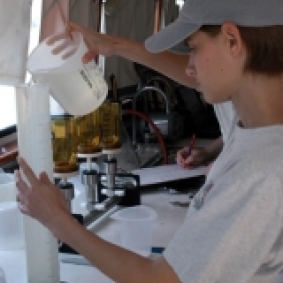Eight students will be presenting the summer work at the Ocean Sciences Meeting in March 2022!
Rebekah (Duncan) Baker, Eckerd College
Class Year:
2003Mentor:
Michael Roman, Ph.D.Project Title:
Grazing Habits of Eurytemora affinis and Acartia tonsa in Turbid and Non-Turbid Environments
Abstract:
Vertical and horizontal plankton tows were performed at two sites in the Choptank River to collect the copepods Eurytemora affinis and Acartia tonsa. E. affinis was collected from the Choptank estuarine turbidity maximum (ETM) and A. tonsa from the Horn Point pier seaward of the Choptank ETM. Adult copepods were selected for a 24 h grazing experiment where they were subjected to feeding in water from each collection site (ETM water and non-ETM water). Feeding was evaluated by gut fluorescence and microscope enumeration of prey before and after the grazing period. Ingestion rates (Is) and gut chl-a content were calculated from gut fluorescence. Ingestion rates (I) and clearance rates (F) for specific prey types were calculated from microscope counts. E. affinis had higher ingestion rates and gut chl-a content than A. tonsa in ETM water. A. tonsa had higher ingestion rates and gut chl-a content than E. affinis in non-ETM water. E. affinis' ingestions rates and gut chl-a content did not change from ETM to non-ETM water. Both copepod species showed a preference for prey >20 μm revealing a trophic cascade.
Location:
Horn Point LaboratoryPresentations:
Duncan, R.*, M. Roman, S. Lloyed, and J. M. Lessmann. 2004. Grazing habits of the estuarine copepods Eurytemora affinis and Acartia tonsa in turbid and non-turbid environments in the Chesapeake Bay . Southeastern Estuarine Research Society, Harbor Branch Institute, Florida .




